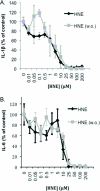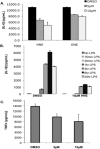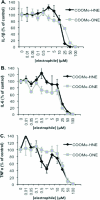Structure-activity analysis of diffusible lipid electrophiles associated with phospholipid peroxidation: 4-hydroxynonenal and 4-oxononenal analogues
- PMID: 21291287
- PMCID: PMC3062932
- DOI: 10.1021/tx100323m
Structure-activity analysis of diffusible lipid electrophiles associated with phospholipid peroxidation: 4-hydroxynonenal and 4-oxononenal analogues
Abstract
Electrophile-mediated disruption of cell signal-ing is involved in the pathogenesis of several diseases including atherosclerosis and cancer. Diffusible and membrane bound lipid electrophiles are known to modify DNA and protein substrates and modulate cellular pathways including ER stress, antioxidant response, DNA damage, heat shock, and apoptosis. Herein we report on a structure-activity relationship for several electrophilic analogues of 4-hydroxynonenal (HNE) and 4-oxononenal (ONE) with regard to toxicity and anti-inflammatory activity. The analogues studied were the oxidation products of HNE and ONE, HNEA/ONEA, the in vivo hydrolysis products of oxidized phosphatidylcholine, COOH-HNE/COOH-ONE, and their methyl esters, COOMe-HNE/ONE. The reactivity of each compound toward N-acetylcysteine was determined and compared to the toxicity toward a human colorectal carcinoma cell line (RKO) and a human monocytic leukemia cell line (THP-1). Further analysis was performed in differentiated THP-1 macrophages to assess changes in macrophage activation and pro-inflammatory signaling in response to each lipid electrophile. HNE/ONE analogues inhibited THP-1 macrophage production of the pro-inflammatory cytokines, IL-6, IL-1β, and TNFα, after lipopolysaccharide (LPS)/IFNγ activation. Inhibition of cytokine production was observed at submicromolar concentrations of several analogues with as little as 30 min of exposure. Phagocytosis of fluorescent beads was also inhibited by lipid electrophile treatment. Lipid electrophiles related to HNE/ONE are both toxic and anti-inflammatory, but the anti-inflammatory effects in human macrophages are observed at nontoxic concentrations. Neither toxicity nor anti-inflammatory activity are strongly correlated to the reactivity of the model nucleophile, N-acetylcysteine.
Figures












Similar articles
-
Systems analysis of protein modification and cellular responses induced by electrophile stress.Acc Chem Res. 2010 May 18;43(5):673-83. doi: 10.1021/ar900286y. Acc Chem Res. 2010. PMID: 20218676 Free PMC article. Review.
-
Inhibition of the lipopolysaccharide-induced stimulation of the members of the MAPK family in human monocytes/macrophages by 4-hydroxynonenal, a product of oxidized omega-6 fatty acids.Am J Pathol. 2008 Oct;173(4):1057-66. doi: 10.2353/ajpath.2008.071150. Epub 2008 Sep 4. Am J Pathol. 2008. PMID: 18772336 Free PMC article.
-
Measuring electrophile stress.Curr Protoc Toxicol. 2009;Chapter 17:Unit17.11. doi: 10.1002/0471140856.tx1711s40. Curr Protoc Toxicol. 2009. PMID: 23045010
-
Heat shock factor 1 attenuates 4-Hydroxynonenal-mediated apoptosis: critical role for heat shock protein 70 induction and stabilization of Bcl-XL.J Biol Chem. 2007 Nov 16;282(46):33412-33420. doi: 10.1074/jbc.M706799200. Epub 2007 Sep 16. J Biol Chem. 2007. PMID: 17873279
-
Pro-apoptotic effects of lipid oxidation products: HNE at the crossroads of NF-κB pathway and anti-apoptotic Bcl-2.Free Radic Biol Med. 2017 Oct;111:209-218. doi: 10.1016/j.freeradbiomed.2016.11.010. Epub 2016 Nov 10. Free Radic Biol Med. 2017. PMID: 27840321 Review.
Cited by
-
A generalizable platform for interrogating target- and signal-specific consequences of electrophilic modifications in redox-dependent cell signaling.J Am Chem Soc. 2015 May 20;137(19):6232-44. doi: 10.1021/ja5132648. Epub 2015 May 5. J Am Chem Soc. 2015. PMID: 25909755 Free PMC article.
-
Privileged Electrophile Sensors: A Resource for Covalent Drug Development.Cell Chem Biol. 2017 Jul 20;24(7):787-800. doi: 10.1016/j.chembiol.2017.05.023. Epub 2017 Jun 22. Cell Chem Biol. 2017. PMID: 28648380 Free PMC article. Review.
-
Application of the Hard and Soft, Acids and Bases (HSAB) theory to toxicant--target interactions.Chem Res Toxicol. 2012 Feb 20;25(2):239-51. doi: 10.1021/tx2003257. Epub 2011 Nov 16. Chem Res Toxicol. 2012. PMID: 22053936 Free PMC article. Review.
-
N-aldehyde-modified phosphatidylethanolamines generated by lipid peroxidation are robust substrates of N-acyl phosphatidylethanolamine phospholipase D.J Lipid Res. 2025 Jul;66(7):100831. doi: 10.1016/j.jlr.2025.100831. Epub 2025 May 21. J Lipid Res. 2025. PMID: 40409473 Free PMC article.
-
Role of Natural and Synthetic Compounds in Modulating NRF2/KEAP1 Signaling Pathway in Prostate Cancer.Cancers (Basel). 2023 Jun 2;15(11):3037. doi: 10.3390/cancers15113037. Cancers (Basel). 2023. PMID: 37296999 Free PMC article. Review.
References
-
- Niki E. (2009) Lipid peroxidation: Physiological levels and dual biological effects. Free Radical Biol. Med. 47, 469–484. - PubMed
-
- Jacobs A. T.; Marnett L. J. (2007) Heat shock factor 1 attenuates 4-hydroxynonenal-mediated apoptosis: Critical role for heat shock protein 70 induction and stabilization of Bcl-XL. J. Biol. Chem. 282, 33412–33420. - PubMed
-
- West J. D.; Marnett L. J. (2005) Alterations in gene expression induced by the lipid peroxidation product, 4-hydroxy-2-nonenal. Chem. Res. Toxicol. 18, 1642–1653. - PubMed
Publication types
MeSH terms
Substances
Grants and funding
LinkOut - more resources
Full Text Sources

